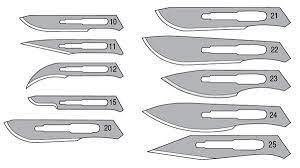Maintaining Surgical Blade Sterility: Best Practices for Healthcare Professionals

Ensuring the sterility of Surgical Blades is a critical aspect of surgical practice. Contaminated blades can lead to surgical site infections (SSIs), prolonged hospital stays, and increased healthcare costs. Therefore, maintaining the sterility of surgical blades is essential for patient safety and optimal surgical outcomes. This comprehensive guide outlines the best practices for healthcare professionals to ensure the sterility of surgical blades before, during, and after surgery.
Understanding Sterility and Its Importance
Sterility refers to the absence of all living microorganisms, including bacteria, viruses, fungi, and spores. In the context of surgical instruments, sterility is crucial because even a single microorganism can cause an infection. Surgical site infections are associated with increased morbidity and mortality, making sterility a top priority in surgical procedures.
Pre-Surgery Sterility Protocols
Sterile Storage
Surgical blades should be stored in a sterile environment until they are needed. This involves:
Sealed Packaging: Blades should be stored in their original sealed packaging until use to prevent contamination.
Controlled Environment: Storage areas should be clean, dry, and free from dust and pests. Temperature and humidity should be controlled to prevent microbial growth.
Regular Inspections: Storage conditions should be regularly inspected, and expired or damaged packaging should be discarded.
Handling and Transportation
The transportation of surgical blades from storage to the operating room must be conducted with care to maintain sterility:
Sterile Containers: Use sterile, closed containers for transporting blades.
Minimize Handling: Reduce the handling of blades to avoid contamination. Use sterile gloves and instruments to handle blades.
Direct Transfer: Transport blades directly to the sterile field to minimize exposure to potential contaminants.
Intra-Surgery Sterility Protocols
Aseptic Technique
Maintaining sterility during surgery involves strict adherence to aseptic techniques:
Sterile Field: Establish a sterile field using sterile drapes and ensure all personnel adhere to sterile protocols.
Sterile Gloves and Gowns: Surgeons and surgical staff must wear sterile gloves and gowns. Gloves should be changed immediately if they become contaminated.
Instrument Handling: Use sterile instruments to handle surgical blades. Avoid touching non-sterile surfaces with sterile instruments.
Blade Management
Proper management of surgical blades during the procedure is essential:
Single-Use Blades: Whenever possible, use single-use blades to eliminate the risk of cross-contamination.
Immediate Disposal: After use, blades should be immediately disposed of in designated sharps containers to prevent accidental contamination or injury.
Sterile Back-Up: Have sterile backup blades readily available to replace any blade that becomes contaminated during the procedure.
Post-Surgery Sterility Protocols
Blade Disposal
Disposal of used surgical blades must be conducted safely and hygienically:
Sharps Containers: Dispose of blades in puncture-proof, clearly labeled sharps containers to prevent needle-stick injuries and maintain safety.
Regulated Waste Management: Follow local regulations and guidelines for the disposal of medical waste to ensure environmental and public safety.
Sterilization of Reusable Blades
For procedures that involve reusable blades, rigorous sterilization protocols must be followed:
Initial Cleaning: Immediately after use, blades should be cleaned to remove blood and tissue residues. Use appropriate cleaning agents and methods.
Sterilization Methods: Sterilize blades using autoclaving, chemical sterilization, or other approved methods. Ensure that the entire blade is exposed to the sterilizing agent.
Sterility Assurance: Use biological indicators and sterilization integrators to verify the effectiveness of the sterilization process.
Training and Education
Staff Training
Regular training and education for all healthcare staff involved in surgical procedures are essential:
Aseptic Techniques: Provide training on aseptic techniques and the importance of maintaining sterility.
Sterilization Procedures: Educate staff on the proper cleaning and sterilization methods for reusable blades.
Emergency Protocols: Train staff on how to handle breaches in sterility, including immediate corrective actions.
Continuing Education
Healthcare is an evolving field, and ongoing education is crucial:
Updated Guidelines: Keep staff informed about the latest guidelines and best practices in surgical blade sterility.
Workshops and Seminars: Encourage participation in workshops and seminars focused on infection control and sterilization.
Quality Control and Monitoring
Regular Audits
Conduct regular audits of sterilization and storage practices:
Compliance Checks: Ensure adherence to established protocols and guidelines.
Documentation: Maintain detailed records of sterilization cycles, storage conditions, and staff training.
Infection Control Committees
Establish infection control committees to oversee and improve sterility practices:
Policy Development: Develop and update policies related to surgical blade sterility.
Incident Review: Review and analyze any incidents of contamination or infection to identify areas for improvement.
Conclusion:
Maintaining the sterility of surgical blades is a multifaceted process that requires vigilance, proper protocols, and ongoing education. From pre-surgery storage and handling to intra-surgery aseptic techniques and post-surgery sterilization, each step is crucial in preventing infections and ensuring patient safety. Healthcare professionals must be committed to upholding the highest standards of sterility, supported by regular training, rigorous quality control, and adherence to best practices. By doing so, they can significantly reduce the risk of surgical site infections and enhance overall surgical outcomes, ultimately contributing to better patient care and safety.



